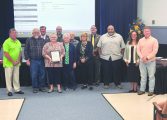By Ruthann Carr
Correspondent
 Best. Meeting. Ever.
Best. Meeting. Ever.
Probably because it wasn’t one.
The regular meeting of the Fluvanna School Board on Thursday (April 14) didn’t happen.
People gathered, but because only two school board members showed up – Gequetta Murray-Key (Rivanna) and Chair James Kelley (Palmyra) – there wasn’t a quorum to conduct official business.
Although no formal matters were decided, Kelley chose not to send home the delegations scheduled to present.
Those who did show up were treated to what is arguably the best of Fluvanna Public Schools: Engaged students and teachers.
The night was full of teaching and learning.
It was school.
Teacher Nick Ward reported on the Fluvanna Medford League basketball team that won the Medford tournament. During the three-month season, the Fluvanna team was undefeated, finishing 6-0 in the regular season against local schools Orange County, Eastern View, Goochland, Culpeper, William Monroe, and Madison High School.
Ward said Fluvanna began competing in the Medford League in 2015.
“We didn’t win one game the first year and this year we won the tournament,” he said.
The team consisted of players Euneka Booker, Aaliyah Lewis, George Gibson, Shantika Hawkins, Lizzie Williams, Kelcie Edmonds, Natalie Simmons, Dalton McClurken, Dare Opaleye, Mia Childress, Marcus Wells, Landon Critzer.
Ward called each player’s name and handed them a certificate.
Board members Murray-Key and Kelley posed for pictures with the team.
Director of Special Education Jennifer Valentine said the Fluvanna Medford team was also one of only 11 (out of 132) awarded a banner for their play.
Next up was the KidWind Challenge team.
Team coach and Middle School Librarian Eric Drongowski explained: “KidWind is a renewable energy design and construction competition that engages students through the lens of wind and solar energy. Student teams design, construct and test small-scale wind turbines and solar structures at events all over the world.”
The challenge is a perk of the school’s relationship with SunTribe Solar, the company Fluvanna Public Schools contracted with to provide solar energy to the schools.
Drongowski said six teams formed to compete and in three weeks designed, built and tested projects.
Team members learned to create, problem-solve, fail, cooperate and fix design flaws.
Three teams created wind turbines.
The others created a ferry, greenhouse and radio – all solar-powered.
While competing against 20 other teams at James Madison University, Fluvanna won four awards for unique blade design, overcoming obstacles, a Peoples’ Choice award and second place in the solar division with an invitation to the state competition on April 23.
Drongowski said this type of hands-on learning is vital.
“Responding to these types of situations and ‘bumps in the road’ in the course of pursuing a goal seems to me to be as valuable for students as accomplishing the goal,” he said. “Exploring content areas with hands-on activities offers potential for learning in a way that traditional learning often does not. There are many factors to consider regarding Project Based Learning. From the Buck Institute for Education, Research shows that PBL can promote student learning and may be more effective than traditional instruction in social studies, science, mathematics, and literacy.”
As this was an informal meeting, board members asked the students about their projects and listened as they told about problems of blade design they overcame and improvements they made to their greenhouse.
Superintendent Peter Gretz introduced Instructional Technology Resource teachers Pam Loving and Amy Hartwell.
“I am blown away by their passion for kids, their heart for kids and their ability to connect with kids,” Gretz said. “They are a picture of the kind of instruction and the kind of engagement we’d love to see in every single classroom.”
Loving explained how they work with students in Pre-K through fourth grade.
The program is called Project Lead the Way.
It is the foundation that prepares students to work in efforts like the KidWind challenge.
Each lesson Loving teaches starts with a story and a problem.
In one lesson, students read The Three Little Pigs. Each group built a house that had to withstand the Big Bad Wolf (a wolf puppet covering the nozzle of a leaf blower).
They then designed and tested a painting tool.
Hartwell said the STEAM lab (Science, Technology, Engineering, Arts, Math) teaches the five Cs: communication, collaboration, character, critical-thinking and creativity.
She worked with students doing computer science programming, force and motion and circuitry. Those involved pumpkin rolling, building the Great Wall of China and sailing to the new world.
Hartwell said it’s tempting for teachers and parents to step in to help students when they see them struggling.
Her rule is help when asked.
“They’ll tell you when they need your help,” she said.
In the audience were several AP Government students who came to the meeting as part of a class requirement.
Kelley and Murray-Key asked them for their thoughts and comments.
Almost every one said they wish they had that type of instruction when they were younger.




